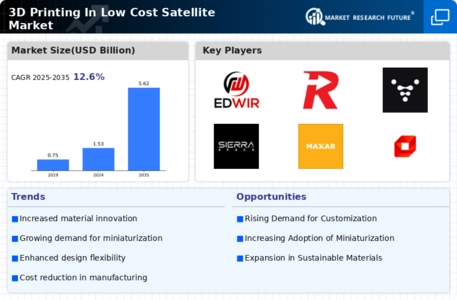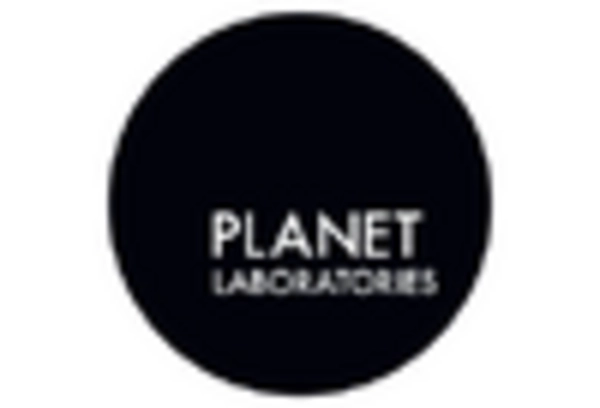The 3D Printing in Low Cost Satellite Market is currently characterized by a dynamic competitive landscape, driven by technological advancements and the increasing demand for cost-effective satellite solutions. Key players such as Relativity Space (US), Rocket Lab (NZ), and Northrop Grumman (US) are at the forefront, each adopting distinct strategies to enhance their market positioning. Relativity Space (US) focuses on innovation through its proprietary 3D printing technology, which allows for rapid prototyping and reduced manufacturing costs. Rocket Lab (NZ) emphasizes regional expansion, particularly in the U.S. market, to capitalize on the growing demand for small satellite launches. Northrop Grumman (US) leverages its extensive experience in aerospace to integrate advanced manufacturing techniques, thereby enhancing operational efficiency and product reliability. Collectively, these strategies contribute to a competitive environment that is increasingly centered on technological prowess and operational agility.
In terms of business tactics, companies are increasingly localizing manufacturing to reduce lead times and optimize supply chains. The market structure appears moderately fragmented, with several players vying for market share while also collaborating on various projects. This fragmentation allows for a diverse range of offerings, but the influence of key players remains substantial, as they set benchmarks for innovation and operational excellence.
In August 2025, Relativity Space (US) announced a partnership with a leading satellite communications provider to develop a new line of satellites utilizing their 3D printing technology. This collaboration is strategically significant as it not only enhances Relativity's product offerings but also positions the company as a key player in the satellite communications sector, potentially increasing its market share and visibility.
In September 2025, Rocket Lab (NZ) successfully launched its Photon satellite, which was partially constructed using 3D printing techniques. This milestone underscores Rocket Lab's commitment to integrating advanced manufacturing processes into its satellite production, thereby reducing costs and improving turnaround times. The successful deployment of Photon is likely to bolster Rocket Lab's reputation as a leader in the small satellite market, attracting further investment and partnerships.
In July 2025, Northrop Grumman (US) unveiled its new satellite platform designed specifically for 3D printing, which aims to streamline the production process and enhance customization capabilities. This initiative reflects Northrop Grumman's strategic focus on innovation and efficiency, potentially setting a new standard in the industry for satellite manufacturing. The introduction of this platform may also encourage other players to adopt similar technologies, thereby accelerating the overall market evolution.
As of October 2025, current competitive trends indicate a strong emphasis on digitalization, sustainability, and the integration of artificial intelligence within manufacturing processes. Strategic alliances are increasingly shaping the landscape, as companies recognize the value of collaboration in driving innovation and expanding market reach. Looking ahead, competitive differentiation is likely to evolve from traditional price-based competition to a focus on technological innovation, supply chain reliability, and sustainable practices, suggesting a transformative shift in how companies approach market challenges.

















Leave a Comment